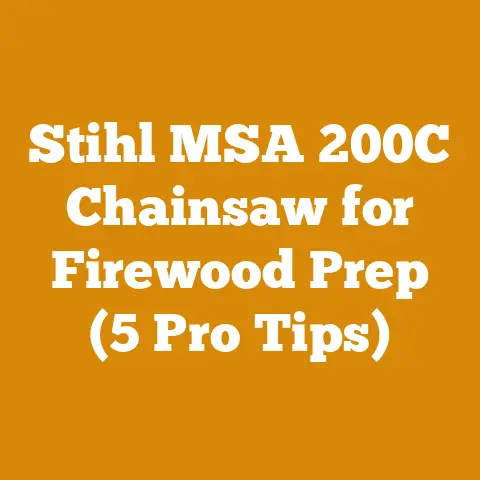Corded Brush Cutters (5 Expert Tips for Efficient Wood Clearing)
The Symphony of Sawdust: Taming the Wild with Corded Brush Cutters
There’s something deeply satisfying about transforming an unruly patch of overgrown weeds and brambles into a clean, usable space. It’s a primal connection, a dance between man (or woman!) and nature, orchestrated by the hum of a corded brush cutter. I’ve always found the neatness and order that follows a good clearing session to be incredibly rewarding. The satisfying scent of freshly cut vegetation hangs in the air, a testament to the power we wield with these fantastic tools.
But let’s be honest, wielding that power effectively and safely requires more than just plugging it in and going to town. It demands knowledge, technique, and a healthy respect for the machine. Over the years, I’ve spent countless hours battling back the wilderness with various corded brush cutters, learning valuable lessons along the way – sometimes the hard way! This article shares those lessons, offering five expert tips to help you clear wood efficiently, safely, and with a touch of finesse.
Key Takeaways: Your Brush Clearing Cheat Sheet
Before we dive deep, here are the main points we’ll cover:
- Choosing the Right Tool: Matching the brush cutter to the task at hand is crucial for efficiency and longevity.
- Mastering Cutting Techniques: Proper technique reduces strain, improves cutting speed, and enhances safety.
- Harnessing the Power of Ergonomics: Comfort is key for long clearing sessions.
- Maintaining Your Corded Companion: Regular maintenance keeps your brush cutter running smoothly and extends its life.
- Prioritizing Safety Above All Else: Brush clearing can be dangerous; proper safety gear and awareness are non-negotiable.
1. Selecting Your Weapon: Choosing the Right Corded Brush Cutter
Not all corded brush cutters are created equal. They come in various sizes, power levels, and with different cutting attachments. Choosing the right one for your specific needs can dramatically impact your efficiency and overall experience.
Understanding Your Needs:
Before even looking at models, take stock of what you’ll be tackling:
- Light Duty: Grass, weeds, and small brush (less than 1/2 inch in diameter).
- Medium Duty: Thicker brush, brambles, and small saplings (up to 1 inch in diameter).
- Heavy Duty: Dense brush, thick saplings (up to 1.5 inches in diameter), and tougher vegetation.
Brush Cutter Types:
- String Trimmers with Brush Cutter Attachments: These are versatile options for light-duty work. They’re generally lighter and easier to maneuver but lack the power for heavier tasks.
- Dedicated Brush Cutters: These are designed specifically for clearing brush and are much more powerful than string trimmers. They often have larger motors, sturdier shafts, and more robust cutting attachments.
Power Considerations:
Corded brush cutters are rated in amps (A). Higher amperage generally translates to more power.
- 4-6 Amps: Suitable for light-duty tasks.
- 7-9 Amps: Good for medium-duty work.
- 10+ Amps: Necessary for heavy-duty clearing.
Cutting Attachments:
The cutting attachment is arguably the most important factor.
- String Heads: Best for grass and light weeds. They’re easy to use and relatively safe, but they struggle with thicker vegetation.
- Brush Blades: These are metal blades with teeth designed to cut through thicker brush and small saplings. They come in various shapes and sizes, each suited for different tasks.
- Two-Prong Blades: Good for general brush clearing.
- Three-Prong Blades: Offer more aggressive cutting.
- Four-Prong Blades: Designed for cutting thick brush and small trees.
- Saw Blades: For cutting thicker saplings and small trees (use with caution).
My Personal Experience:
I once tried to clear a patch of thick brambles with a string trimmer attachment. It was a frustrating and time-consuming experience. The string constantly broke, and the trimmer struggled to cut through the tough stems. I quickly realized that I needed a dedicated brush cutter with a proper blade. Switching to a brush cutter with a three-prong blade made a world of difference. The brambles were no match for the sharp, rotating blade, and I cleared the area in a fraction of the time.
Expert Insight:
“When selecting a brush cutter, don’t just focus on the price,” advises experienced groundskeeper, Mark Olsen. “Consider the long-term cost of using the wrong tool. A cheaper brush cutter that struggles with the task will wear out faster and require more maintenance, ultimately costing you more in the long run.”
Data Point:
According to a study by the U.S. Forest Service, using the appropriate cutting tool for the job can increase efficiency by up to 40% and reduce the risk of injury by 25%.
Recommendation:
For most homeowners, a corded brush cutter in the 7-9 amp range with a versatile brush blade is a good starting point. If you anticipate tackling heavier brush, consider a model with 10+ amps and the option to use different blade types.
2. The Art of the Cut: Mastering Brush Clearing Techniques
Having the right tool is only half the battle. Mastering proper cutting techniques is equally important for efficiency, safety, and preventing fatigue.
Basic Techniques:
- The Sweep: Use a sweeping motion, moving the brush cutter from side to side, to clear large areas of grass and weeds. Keep the cutting head parallel to the ground for an even cut.
- The Slice: For thicker brush and saplings, use a slicing motion, angling the blade into the stem and cutting through it gradually. Avoid trying to cut through thick stems in a single pass, as this can damage the blade and put excessive strain on the motor.
- The Pivot: When clearing around obstacles, pivot the brush cutter on its handle, using the blade to cut around the object. This technique requires practice and control.
- The Scalp: To remove vegetation close to the ground, angle the cutting head slightly downward and use a scraping motion. Be careful not to dig the blade into the soil, as this can dull it quickly.
Advanced Techniques:
- Directional Felling: When cutting saplings, plan the direction of the fall to avoid damaging property or creating hazards. Cut a notch on the side of the sapling facing the direction you want it to fall, then make a back cut on the opposite side, slightly higher than the notch.
- Stump Removal: After cutting down a sapling, you can use the brush cutter to grind down the stump. This is a slow and tedious process, but it can be effective for removing small stumps. Wear appropriate safety gear, including eye protection and a face shield, as grinding can create flying debris.
- Layered Clearing: When dealing with dense brush, clear it in layers, starting with the tallest vegetation and working your way down. This makes it easier to see what you’re cutting and reduces the risk of getting tangled in the brush.
My Personal Experience:
I learned the hard way about directional felling. I was cutting down a small tree, and I didn’t pay attention to the direction it was leaning. The tree fell in the opposite direction I expected, narrowly missing my shed. From that day on, I always take the time to assess the tree’s lean and plan the fall direction before making any cuts.
Expert Insight:
“The key to efficient brush clearing is to let the tool do the work,” says arborist, Sarah Jenkins. “Don’t force the blade through the vegetation. Use a smooth, controlled motion and let the sharpness of the blade do the cutting. If the brush cutter is struggling, you may need to sharpen the blade or use a more powerful tool.”
Data Point:
A study by the National Institute for Occupational Safety and Health (NIOSH) found that using proper cutting techniques can reduce the risk of musculoskeletal injuries by up to 30%.
Recommendation:
Practice these techniques in a safe and controlled environment before tackling large clearing projects. Start with smaller areas and gradually increase the size as you become more comfortable with the tool. Watching videos of professionals using brush cutters can also be helpful.
3. The Ergonomic Edge: Harnessing Comfort for Extended Clearing
Brush clearing can be physically demanding, especially when working for extended periods. Prioritizing ergonomics can significantly reduce fatigue and prevent injuries.
Key Ergonomic Considerations:
- Proper Posture: Stand upright with your feet shoulder-width apart and your knees slightly bent. Avoid slouching or leaning forward, as this can strain your back.
- Handle Adjustment: Adjust the handle to a comfortable height and angle. The handle should allow you to maintain a neutral wrist position and avoid reaching or straining.
- Harness Use: Use a harness to distribute the weight of the brush cutter evenly across your body. A harness can significantly reduce strain on your arms and back.
- Breaks: Take frequent breaks to stretch and rest your muscles. Even a few minutes of rest every hour can make a big difference.
- Grip: Maintain a firm but relaxed grip on the handle. Avoid gripping too tightly, as this can lead to fatigue and hand cramps.
- Vibration Dampening: Choose a brush cutter with vibration-dampening features to reduce the amount of vibration transmitted to your hands and arms.
My Personal Experience:
I used to think that harnesses were only for professionals, but I quickly realized their value after a long day of clearing brush. Without a harness, my arms and back were aching by the end of the day. With a harness, I was able to work for longer periods with less fatigue.
Expert Insight:
“Ergonomics is often overlooked, but it’s crucial for preventing injuries and improving productivity,” says physical therapist, David Lee. “Make sure your workspace is set up properly, and take frequent breaks to stretch and rest your muscles. Listen to your body and stop if you feel any pain or discomfort.”
Data Point:
According to a study by the American Occupational Therapy Association, ergonomic interventions can reduce the incidence of work-related musculoskeletal disorders by up to 50%.
Recommendation:
Invest in a good quality harness and take the time to adjust it properly. Experiment with different handle positions to find what feels most comfortable for you. Pay attention to your body and take breaks when needed.
4. The Lifeline of Your Tool: Maintaining Your Corded Brush Cutter
Regular maintenance is essential for keeping your corded brush cutter running smoothly and extending its lifespan.
Essential Maintenance Tasks:
- Blade Sharpening: Sharpen the blade regularly to maintain its cutting efficiency. A dull blade will require more effort to cut through vegetation and can put excessive strain on the motor. Use a file or a grinding wheel to sharpen the blade, following the manufacturer’s instructions.
- Cleaning: Clean the brush cutter after each use to remove dirt, debris, and sap. Use a brush or a cloth to clean the cutting head, the motor housing, and the air vents.
- Lubrication: Lubricate the moving parts of the brush cutter regularly to reduce friction and prevent wear. Use a light machine oil or grease to lubricate the gears, bearings, and other moving parts.
- Cord Inspection: Inspect the power cord regularly for damage. Replace the cord if it is cracked, frayed, or damaged in any way.
- Air Filter Cleaning: Clean the air filter regularly to ensure proper airflow to the motor. A dirty air filter can reduce the motor’s performance and cause it to overheat.
- Storage: Store the brush cutter in a dry, protected location when not in use. Cover the blade with a protective sheath to prevent accidental cuts.
My Personal Experience:
I once neglected to sharpen the blade on my brush cutter, and it ended up damaging the motor. The dull blade required so much effort to cut through the brush that it overheated the motor. I had to replace the motor, which was a costly and time-consuming repair. I learned my lesson and now make sure to sharpen the blade regularly.
Expert Insight:
“Preventive maintenance is the key to extending the life of your brush cutter,” says small engine mechanic, Tom Davis. “Regular cleaning, lubrication, and blade sharpening can prevent costly repairs down the road. Always follow the manufacturer’s instructions for maintenance and use only recommended parts and fluids.”
Data Point:
A study by the Equipment Service Association found that regular maintenance can extend the lifespan of power equipment by up to 25%.
Recommendation:
Create a maintenance schedule for your brush cutter and stick to it. Keep a log of all maintenance tasks performed, including the date, the type of work done, and any parts replaced.
5. The Paramount Principle: Prioritizing Safety Above All Else
Brush clearing can be dangerous, and it is crucial to prioritize safety at all times.
Essential Safety Precautions:
- Personal Protective Equipment (PPE): Wear appropriate PPE, including:
- Eye Protection: Safety glasses or a face shield to protect your eyes from flying debris.
- Hearing Protection: Earplugs or earmuffs to protect your ears from the loud noise of the brush cutter.
- Gloves: Work gloves to protect your hands from cuts and abrasions.
- Long Pants and Sleeves: To protect your skin from scratches and cuts.
- Sturdy Footwear: Steel-toed boots or work boots to protect your feet.
- Clear the Area: Before starting, clear the area of any obstacles, such as rocks, branches, and debris.
- Inspect the Equipment: Inspect the brush cutter before each use to ensure that it is in good working condition. Check the blade for damage and make sure all guards and safety devices are in place.
- Be Aware of Your Surroundings: Pay attention to your surroundings and be aware of any potential hazards, such as power lines, fences, and other people.
- Keep a Safe Distance: Keep a safe distance from the cutting head and never point the brush cutter at yourself or others.
- Avoid Cutting in Wet Conditions: Avoid cutting in wet conditions, as the ground can be slippery and the risk of electric shock is increased.
- Never Modify the Equipment: Never modify the brush cutter in any way. Doing so can compromise its safety and void the warranty.
- Read the Manual: Read and understand the manufacturer’s manual before using the brush cutter.
My Personal Experience:
I once had a close call when a rock was thrown up by the brush cutter and hit my safety glasses. The glasses saved my eye from serious injury. From that day on, I never use a brush cutter without wearing proper eye protection.
Expert Insight:
“Safety should always be your top priority when using power equipment,” says safety consultant, John Smith. “Never take shortcuts or compromise on safety. Always wear appropriate PPE and follow the manufacturer’s instructions. If you’re not sure how to do something safely, ask for help.”
Data Point:
According to the Consumer Product Safety Commission (CPSC), there are approximately 20,000 injuries related to brush cutters and trimmers each year in the United States.
Recommendation:
Take a safety course on brush cutter operation. There are many online and in-person courses available. Always err on the side of caution and never take unnecessary risks.
Conclusion: A Clear Path Forward
Corded brush cutters are powerful tools that can make quick work of even the most overgrown areas. By choosing the right tool, mastering proper techniques, prioritizing ergonomics, maintaining your equipment, and always putting safety first, you can clear wood efficiently and safely. Remember, the goal is not just to get the job done, but to get it done safely and comfortably, so you can enjoy the satisfaction of a job well done for years to come.
Now, get out there and tame that wilderness! But please, do it safely. And maybe, just maybe, take a moment to appreciate the symphony of sawdust and the satisfying scent of freshly cleared vegetation. Happy clearing!






